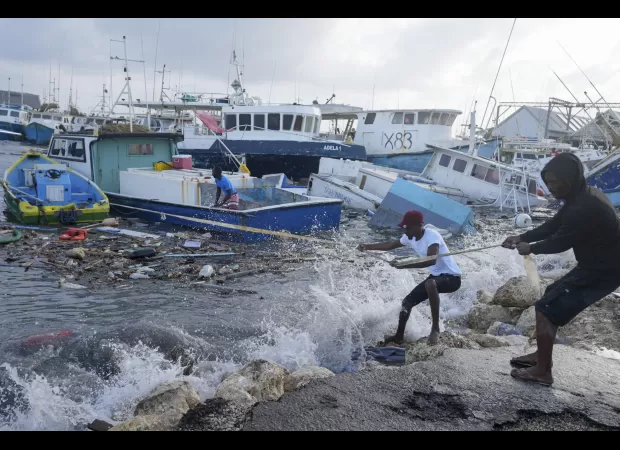The newest storm tracker reveals the predicted location of Hurricane Beryl's next impact.
Jamaica will be impacted on Wednesday, followed by the Cayman Islands on Thursday.

After Hurricane Beryl struck the Caribbean, causing significant damage, fishermen were seen retrieving a damaged boat in Barbados. The tracking data showed the hurricane's path and predicted its next potential destinations. The storm had initially been classified as a Category 4 hurricane, but it was later upgraded to a Category 5 as it headed towards the Gulf of Mexico, fueled by the record warmth of the Atlantic and its devastating winds and storm surge.
The hurricane had already made landfall on Monday morning, hitting Barbados, Grenada, and other West Indies islands. It had caused major damage, resulting in at least one death and thousands of damaged buildings. Its destructive path continued as it charged towards Jamaica, with a predicted arrival on Wednesday, followed by the Cayman Islands on Thursday. Beryl's early arrival marked an exceptionally early hurricane season, as it became the earliest Category 5 hurricane on record, and the second Atlantic storm of such strength in July.
The Agency had the most up-to-date information on Hurricane Beryl, including its current predicted path. As the massive hurricane made its way across the Caribbean, it left a trail of destruction, damaging houses and knocking down trees, as seen in Kingstown, St. Vincent and the Grenadines. The National Hurricane Center reported that Beryl's center was expected to pass Jamaica on Wednesday, after moving quickly across the southeast and central Caribbean Sea on Tuesday.
The latest bulletin from the National Hurricane Center warned of life-threatening winds and storm surge in Jamaica, as the hurricane moved at a rapid pace of 22mph towards the west-northwest direction. The center also reported little change in the hurricane's strength over the past few hours. Beryl was expected to maintain its current direction on Tuesday and Wednesday, before turning west on Thursday. The storm surge could raise water levels up to 6ft in Jamaica and up to 3ft in the Cayman Islands and Hispaniola.
The National Hurricane Center also provided details on when and where Beryl was expected to hit. It had already caused damage in Barbados, Grenada, and other West Indies islands, and was predicted to pass near Jamaica on Wednesday and the Cayman Islands on Thursday. As a Category 5 hurricane on the Saffir-Simpson Hurricane Wind Scale, Beryl was expected to weaken slightly but remain a major hurricane as it approached Jamaica and the Cayman Islands. It was then forecasted to weaken further, but still remain a hurricane as it moved towards the northwestern Caribbean.
The storm's strength and potential damage were measured using the Saffir-Simpson Hurricane Wind Scale, which rates hurricanes on a scale of 1 to 5 based on their maximum sustained wind speed. However, this scale does not take into account other hazards such as storm surge, rainfall flooding, and tornadoes. These hazards, along with the wind, can cause significant property damage. Hurricanes rated Category 3 and higher are considered major hurricanes and can cause catastrophic damage and loss of life due to their powerful winds.
All hurricanes can produce deadly hazards, including storm surge, rain-induced floods, and tornadoes. As a result, it is important for people to take necessary precautions and evacuate from areas that are vulnerable to storm surge. The duration of a hurricane depends on its path and location. If it remains over open water, it can last for two weeks or more, gaining strength from the warm ocean. The Atlantic Ocean typically experiences about 100 tropical disturbances between May and November, with only a few of them becoming hurricanes.
Hurricanes start as low-pressure areas in the atmosphere, and if the conditions are favorable, they can become more organized and gain strength. Once the wind speeds reach 39mph, it is classified as a tropical storm, and if it reaches 74mph, it becomes a hurricane. However, as a hurricane makes landfall or moves over cooler waters, it loses energy and eventually dissipates.






